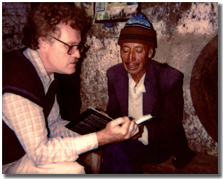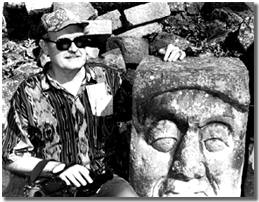
 |
About Dennis Tedlock |
|
 |
Dennis Tedlockwas raised in Albuquerque and Taos. From an early age his parents took him along on their rounds of a world filled with painters and writers. The strongest presences in his memories of Taos are the ghost of D.H. Lawrence and the inexhaustible warmth of his widow, Frieda. The principal scene is the mountainside ranch that was given to the Lawrences by Mabel Dodge Luhan, who came from Buffalo. She had a nephew who also moved to New Mexico but later returned to Buffalo, making a home for himself in the rolling country south of the city. The place he chose, with deer, wild turkeys, and a pond, was destined to become the home of Tedlock and his wife Barbara. While in high school in Albuquerque, Tedlock made numerous visits to Pueblo Indian villages, studied under the Cochiti artist Joe Herrera, joined an archaeological dig, and traveled far into Mexico on his own. At the University of New Mexico he double-majored in art history and anthropology, spending summers drawing and photographing newly-discovered murals at a nearby Anasazi ruin. For graduate work he went off to New Orleans, concentrating on archaeology during his first year at Tulane. That summer he got a job as a dig foreman in the remotest reach of Navajo country, and by fall he decided to change his field of study to living cultures. Crossing over to the ethnographic and linguistic side of anthropology, he did his doctoral research on the art of storytelling among the Zuni of New Mexico. For the last three decades Tedlock has done all his field work in the company of his wife, who is herself an author and anthropologist. In addition to making periodic visits to Zuni, they have done research in Nigeria, Brazil, and Mongolia. But most of their field work has been conducted among the Mayan peoples of Guatemala and Belize. While living among the Quiché (K’iche’) Maya in the highlands of Guatemala, they underwent formal training and initiation as ajq’ij or “daykeepers,” learning ancient methods of divination and dream interpretation. They have also attended four Maya Hieroglyphic Workshops at the University of Texas. Tedlock has held positions at Iowa State, Berkeley, Brooklyn College, Yale, and Boston University. He has also taught, as a visitor, at Wesleyan (Connecticut), the New School for Social Research, Oregon State, Texas (Austin), British Columbia, Campinas (Brazil), and the Naropa Institute (Boulder). In the spring of 1999 he was a Visiting Professor of Comparative Literature and Folklore at Harvard. Since 1987 he has held the McNulty Chair in English and a research professorship in anthropology at the State University of New York at Buffalo, where he joined Charles Bernstein, Robert Creeley, Raymond Federman, and Susan Howe in forming the nation’s first degree program in poetics. Support for Tedlock’s research, writing, and editing has been provided by grants and fellowships from the NIMH, NEA, NEH, Fulbright Commission, John Simon Guggenheim Foundation, the Institute for Advanced Study in Princeton, and Harvard’s Dumbarton Oaks museum and library in Washington, D.C. For eleven years, with Jerome Rothenberg, he edited and published Alcheringa/Ethnopoetics, billed as “a first magazine of the world’s tribal poetry.” Recently he and Barbara Tedlock completed a four-year term as editors-in-chief of the American Anthropologist. Their efforts to brighten the pages of this century-old journal with innovative work were the subject of articles in The Chronicle of Higher Education and Lingua Franca. Articles, essays, poems, and translations by Tedlock have appeared in a wide range of literary magazines and scholarly journals, not only in this country but in Brazil, Canada, Germany, Italy, Japan, and Mexico. His first book, Finding the Center: Narrative Poetry of the Zuni Indians, was nominated for a National Book Award. For Popol Vuh: The Mayan Book of the Dawn of Life he received the PEN Translation Prize. Days from a Dream Almanac, which he not only authored but illustrated and de-signed, was selected for the Book, Jacket, and Journal Show of the Association of American University Presses, and it also won the Victor Turner Prize for Ethnographic Writing. For Breath on the Mirror: Mythic Voices and Visions of the Living Maya he added the role of compositor to those of author and designer. His most recent book, Rabinal Achi: A Mayan Drama of War and Sacrifice, was named by the Association of American Publishers as the best scholarly book of 2003 in the fields of language and literature, and it also won the Edward Sapir Prize of the Society for Linguistic Anthropology. His edited works are Teachings from the American Earth: Indian Religion and Philosophy, with Barbara Tedlock, and The Dialogic Emergence of Culture, with Bruce Mannheim. Nearing completion is The Human Work, the Human Design: The First 2,000 Years of Mayan Literature, which will be the first book to present the hieroglyphic and alphabetic works of Mayan authors between the same two covers. BODY OF WORKS: - Popol Vuh: The Definitive Edition of the Mayan Book of the Dawn of Life and the Glories of Gods and Kings (Translator) - Finding the Center: Narrative Poetry of the Zuni Indians (Translator) - Finding the Center: The Art of the Zuni Storyteller, Vol. 2 - Rabinal Achi: A Mayan Drama of War and Sacrifice (Translator) - Spoken Word and the Work of Interpretation - Breath on the Mirror: Mythic Voices and Visions of the Living Maya (with Jim Sagel) - Breath on the Mirror: Walking the World of Mayan Myths - Days from a Dream Almanac - The Princes of Naranja: An Essay in Anthrohistorical Method (with Paul Friedrich) - Games of the North American Indians: Games of Chance, Vol. 1 & 2 (Introduction) Also Editor of: - Dialogic Emergence of Culture (with Bruce Man) - Teachings from the American Earth: Indian Religion and Philosophy (with Barbara Tedlock) - Dialogic Emergence of Culture (with Bruce Mannheim) |
| MayaSites Travel Services: U.S. office toll free 877-620-8715 Outside of the U.S. (1) 505-255-2279 E-mail us at [email protected] |